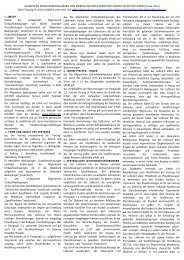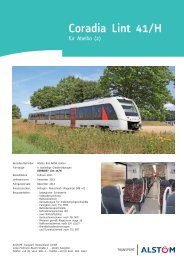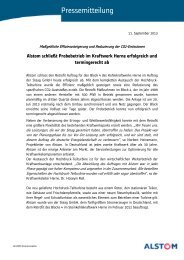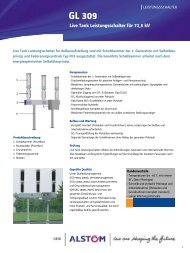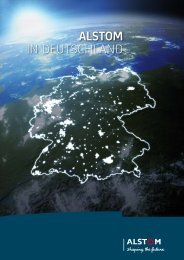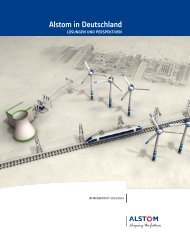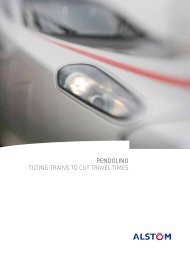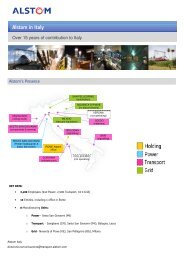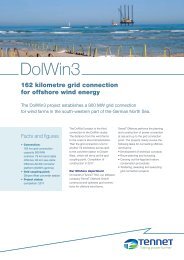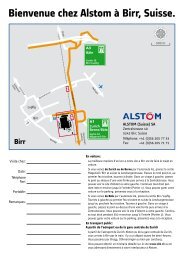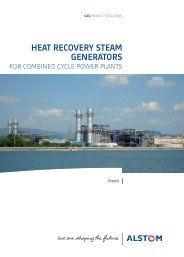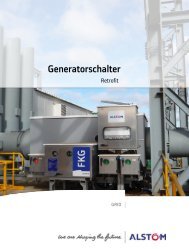MOROCCO IS ACCELERATING! feature - Alstom
MOROCCO IS ACCELERATING! feature - Alstom
MOROCCO IS ACCELERATING! feature - Alstom
Create successful ePaper yourself
Turn your PDF publications into a flip-book with our unique Google optimized e-Paper software.
Only roads and planes can access the tourist<br />
sites of Essaouira, Ouarzazate and Agadir<br />
or even make it possible to penetrate<br />
the immense Sahara. The construction work<br />
on a 954 km ‘line of unity’, between<br />
Marrakech, Agadir and Laayoune, has come<br />
to nothing.<br />
The Moroccan network serves both<br />
passenger and freight transport, with<br />
the exception of a track in the north-east,<br />
between Oujda and Bouarfa, specifi cally<br />
dedicated to phosphate convoys,<br />
the Kingdom’s most important industrial<br />
asset. For nearly forty years, a few specifi c<br />
events contributed to the development of<br />
trade in this precious mineral and to meeting<br />
Moroccans’ requirements for mobility<br />
between the country’s political and economic<br />
centres. The Benguérir-Youssoufi a-Safi line<br />
was electrifi ed between 1982 and1984.<br />
The construction of 102 kilometres of track<br />
between Nouaceur and Jorf Lasfar provided<br />
a new shipping outlet for phosphate from<br />
1987 onwards. In 1984, the ‘Aouita’, the Train<br />
Navette Rapide (TNR) entered into service<br />
When a train writes history…<br />
*Epic: Industrial and commercial state company.<br />
Marrakech station.<br />
on the Casablanca Port-Rabat Ville line,<br />
connecting the two cities in under an hour.<br />
Ten years later, it was extended as far<br />
as Sale and then Kenitra. In 1995,<br />
the fi rst air-conditioned electric rail cars<br />
appeared on this successful line,<br />
a concept which the ONCF repeated<br />
for the Casablanca-Mohammed V<br />
Airport service.<br />
It was the whistle blasts of one of the fi rst steam locomotives in operation in Morocco which, in 1907,<br />
were to turn the Kingdom’s modern history upside down. The little French Decauville served to transport,<br />
from a nearby quarry, the heavy stones needed to build the port of Casablanca. In a troubled political<br />
climate, its work stirred up the discontent, or even fury of the population: It disturbed the dead resting<br />
in the Muslim cemetery of Sidi Belyou that it passed. Eight European workers were assassinated,<br />
Casablanca occupied and the Protectorate declared soon after.<br />
In 1910, two small mining lines entered service. From 1916 onwards one of the most extensive narrow<br />
gauge (600 mm) networks in the world was developed with 1,200 km of lines. This was rapidly converted<br />
to standard gauge (1,435 mm). Three private franchises, the Compagnie des chemins de fer du Maroc<br />
(CFM), the Compagnie du chemin de fer du Maroc oriental (CMO) and the Compagnie franco-espagnole<br />
du chemin de fer de Tanger à Fès (TF) shared the network’s operation from 1923 onwards. A fi rst line<br />
was electrifi ed four years later, steam traction turning out to be unsuited to the climate. This slow<br />
modernisation continued until the eve of the Second World War. The Anglo-American landing in North Africa<br />
on 8 November 1942 led to intensive use of the network for military operations. After the confl ict,<br />
the general conversion of rolling stock to diesel was intensifi ed, leading to the disappearance of the last<br />
steam locomotives. When Morocco was granted independence, in 1956, it inherited a network which was<br />
relatively modern and in good condition. In 1963, the government bought the three private franchises<br />
to create the Offi ce national des chemins de fer du Maroc (ONCF), an Epic* placed under the supervision<br />
of the Ministry of Equipment and Transport. A new era was beginning…<br />
�<br />
Morocco in a few<br />
fi gures (2009)<br />
Area of 710,000 km 2<br />
31,4 million inhabitants, 54%<br />
of whom are under 25 years old.<br />
GNP of 65 billion euros (2, 070 euros<br />
per inhabitant), 61% of which is<br />
contributed by services (manufactured<br />
products and tourism), 22%<br />
by industry (phosphate mines and<br />
canning) and 17% by agriculture.<br />
Growth rate: 5.2%.<br />
Unemployment rate: 9.1%.<br />
Demographic sources: UNFPA/ PNUD;<br />
economic: DG European Union Treasury.<br />
11



